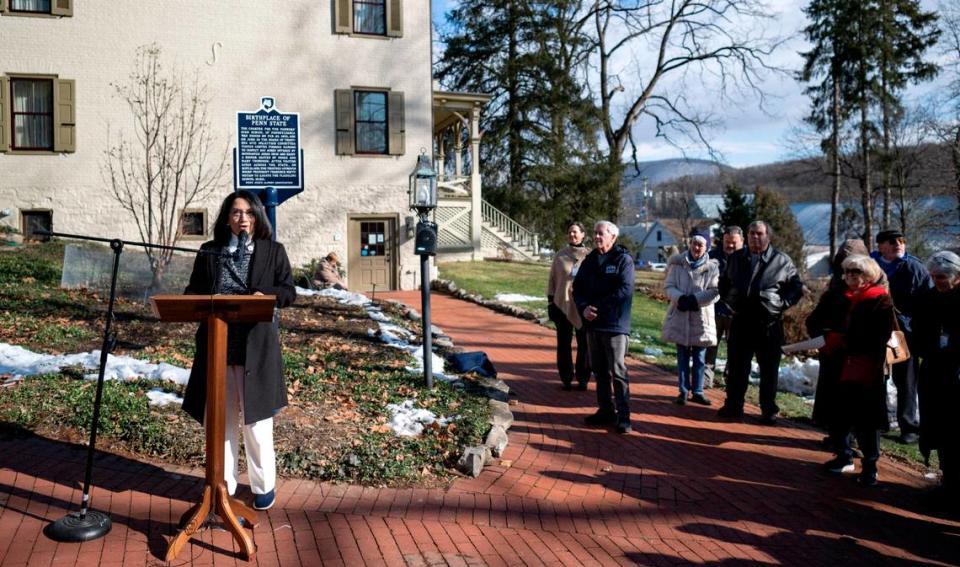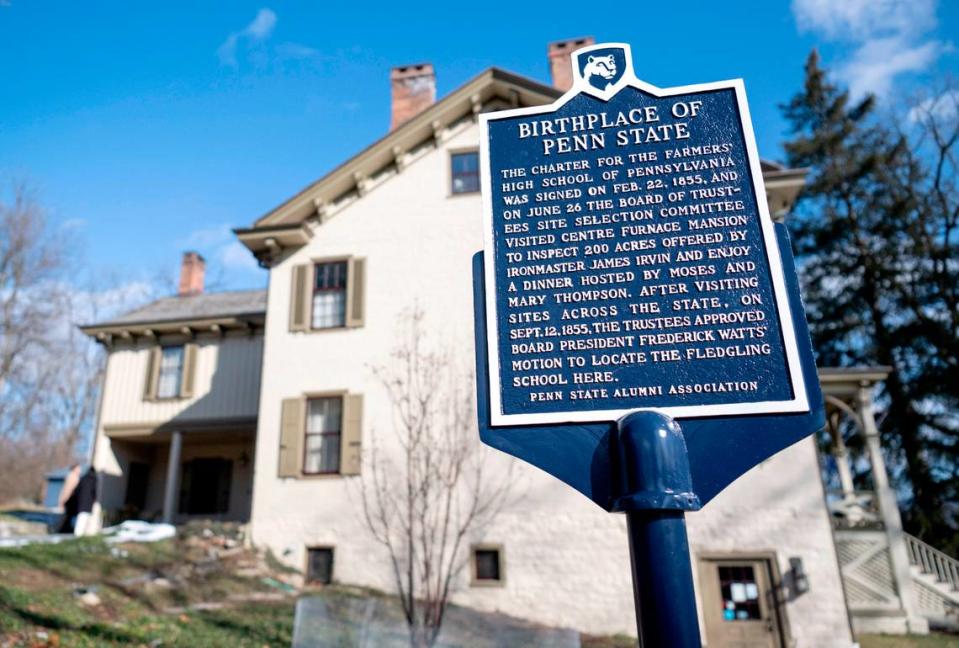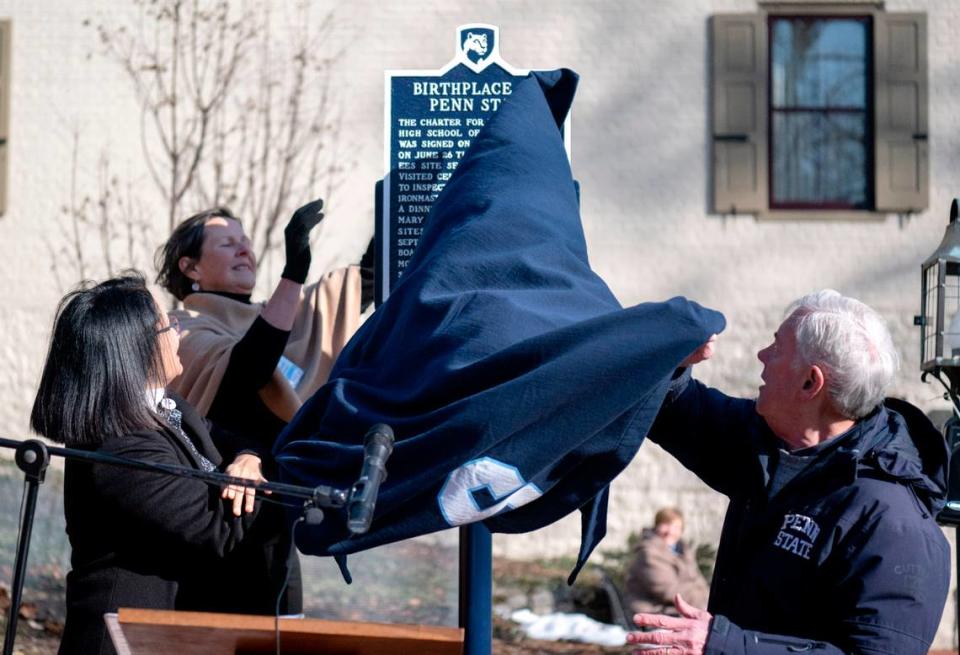Where is Penn State’s birthplace? A new Centre County historical marker celebrates the spot
After nearly a 170-year wait, Penn State finally has a historical marker to commemorate its birthplace.
University President Neeli Bendapudi, joined by more than 40 others in parkas and large winter coats, dedicated a new campus historical marker Thursday afternoon titled “Birthplace of Penn State.” The marker sits just outside the Centre Furnace Mansion near the corner of Porter Road and East College Avenue.
“It’s exciting for me to think what happened here a couple hundred years ago, as this historical marker celebrates the Centre Furnace Mansion playing a starring role in the foundation of our beloved Penn State University,” Bendapudi told a crowd consisting of local officials, alumni and historical society board members.
The humble origins of Pennsylvania’s largest university took root in 1855, when the charter was signed in February and the trustees simply needed to find a location for the new school that was strictly focused on agriculture. State College and central Pennsylvania weren’t always a shoo-in; trustees also looked at sites in Allegheny, Blair and Erie counties.
But it was here near the Centre Furnace Mansion — founded in the 1790s, as the home to the local ironmaster — where community leaders made their case.
Former state Rep. James Irvin, an agriculturalist and ironmaster himself, offered to donate 200 acres for the new school. And, on June 26, 1855, about 150 local community members welcomed the visiting trustees, who were there to inspect the site. A “sumptuous dinner” — as described by an 1883 publication — greeted them inside Centre Furnace Mansion. And, three months later on Sept. 12, the board of trustees approved board President Frederick Watts’ motion to locate the school there.
“Up until that point, higher education was only for the elite,” Bendapudi told the crowd. “And the idea is, how do we bring education not just for some people but for everyone? So they truly understood what higher education can do to improve not just one person’s life but to have those ripple effects on their families and communities.”

Of course, the fledgling school wasn’t initially known as Penn State. That would come later. In the beginning, it was called the “Farmers’ High School of Pennsylvania.” To be clear, it was a college and not an actual high school — but the name was a bit of a marketing ploy because farmers looked upon colleges and universities as exclusively for the elite. Plus, at the time, none offered degrees in agriculture — and this school would be the first. Avoiding the word “college” in the name was intentional, according to Centre County Historical Society President Roger Williams.
On Thursday, with that background swirling in the minds of several dozen attendees, people snapped photos of the historical marker that was installed in November but was only recently publicized and dedicated. Despite the offer of warm coffee and cider inside the mansion, home to the Centre County Historical Society, many lingered outdoors to read the marker and reflect on Penn State’s history.
The marker reads: “The charter for the Farmers’ High School of Pennsylvania was signed on Feb. 22, 1855. And on June 26 the board of trustees site selection committee visited Centre Furnace Mansion to inspect 200 acres offered by ironmaster James Irvin and enjoy a dinner hosted by Moses and Mary Thompson. After visiting sites across the state, on Sept. 12, 1855, the trustees approved board President Frederick Watts’ motion to locate the fledgling school here.”

According to Williams, of the historical society, those 200 donated acres consisted mainly of what is now the central core of University Park. That initial square of land included property from what is now Atherton Street to around Shortlidge Road, and then from Park Avenue to College Avenue.
Thursday’s dedication proved to be relatively brief, less than 30 minutes in all, as the temperature hovered in the low-40s. Several attendees expressed gratitude it wasn’t colder, or snowing. And Williams seemed less concerned with the ceremony’s length and more focused on the marker itself, which he hoped would increase visits to the site and the mansion/historical society.
After all, Penn State boasts a rich history. After it was founded in 1855, as the nation’s first school to offer bachelor’s degrees in agriculture, the Morrill Act of 1862 — also known as the Land Grant College Act — set the stage for the school to expand its curriculum in engineering, the sciences and the liberal arts by the 1880s.
The commonwealth campuses began in the 1930s, in response to the Great Depression, which made more Pennsylvania residents cognizant of cost and convenience. And those campuses ramped up in the 1950s.
Today, as Bendapudi noted, 96% of Pennsylvanians live within 30 miles of a Penn State campus. And, after 169 years, they now know the exact spot where they can trace those origins — less than a mile from Beaver Stadium, a stark contrast from the university’s first class of students, which numbered less than 100.
“It means a lot to me to basically see the Centre Furnace Mansion and the folks who, 169 years ago, were trying to bring this Farmers’ High School into existence to finally have it more visibly recognized to the public,” Williams said after the ceremony.
The marker is among the 68 campus historical markers sponsored by the Penn State Alumni Association. More information on Penn State’s birthplace can be found at centrehistory.org, and tours inside the mansion are available by appointment between 1 and 4 p.m. Wednesday, Friday and Sunday.


